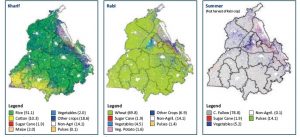
Agricultural Production and Cropping Pattern
The total production of foodgrains has increased over the years. It was 192.18 lakh metric tons in 1990-91 and showed increase of 38.95% in 2014-15(P) i.e. 267.03 lakh metric tons. Further, it is estimated that the production of foodgrains would be 286.05(E) lakh metric ton in 2015-16.
The production of the wheat has increased by 24.09% and the production of rice has increased by 70.72% from 1990-91 to 2014-15 (P). During 2015-16(E), the production of wheat was 171 lakh metric tons and the production of rice is 106.20 lakh metric tons. However, the production of pulses have increased from 0.09 lakh metric ton in 2014-15(P) to 0.38 lakh metric tons in 2015-16(E). The production of sugarcane has show different trends over the years, as it deceased from 6.01 lakh metric tons in 1990-91 to 4.17 lakh metric tons in 2010-11. It increased during 2012-13 (4.89 lakh metric tons) to 2014-15 (5.81 lakh metric tons) and estimated to increase to 6.63 lakh metric tons in 2015-16. The production of cotton (cleaned) has decreased from 14.91 lakh bales in 2013-14 to 13.42 lakh bales in 2014-15(P) and further to 5.22 lakh bales in 2015-16(E).
Production of Major Crops in Punjab
The state has witnessed a considerable change on cropping pattern in the post green revolution era with major focus on wheat-paddy crop rotation. The area under wheat and paddy has increased manifolds during the last 5 decades, whereas the area under oilseeds, pulses, maize other cereals, etc has decreased sharply. The area under cotton & sugarcane has remained more or less constant. The HYVs have replaced the multi- cropping pattern with monoculture of wheat and rice resulting in exploitation of natural resources of state especially water and soil, besides leading to loss of floral biodiversity. Most HYVs are highly input intensive leading to higher use of irrigation water, fertilizers and pesticides for their optimum growth and yield. The cropping intensity (ratio of net sown area to gross cropped area) in the state has increased sharply from 126% in 1960-61 to 191 in 2012-13 with adoption of input intensive agricultural practices. As per State of Indian Agriculture Report, 2012-13, Punjab has the highest cropping intensity in the country closely followed by West Bengal (185%), Haryana (181%), Himachal Pradesh (173%) and Orrisa (162%) as compared to all India percentage 138%. 
Increase in cropping intensity in Punjab
Wheat and Paddy cover the major portion of the gross cropped area and area under these two crops has increased from 47 % in 1970-71 to 80.77% in 2012-13. Area under wheat has however decreased marginally from 35.17 lakh hectares in 2012-13 to 35.12 lakh hectares in 2013-14(P) and is expected to decline to 34.70 lakh hectares during 2014-15(E). Area under Paddy was slightly increased from 28.49 lakh hectares in 2012-13 to 28.51 lakh hectares in 2013-14.
Final Destination for Punjab PSC Notes and Tests, Exclusive coverage of PPSC Prelims and Mains Syllabus, Dedicated Staff and guidence for Punjab PSC PPSC Notes brings Prelims and Mains programs for PPSC Prelims and PPSC Mains Exam preparation. Various Programs initiated by PPSC Notes are as follows:-
- PPSC Mains Tests and Notes Program
- PPSC Prelims Exam 2024- Test Series and Notes Program
- PPSC Prelims and Mains Tests Series and Notes Program
- PPSC Detailed Complete Prelims Notes
